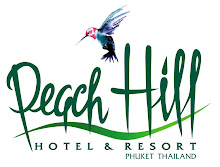



Peach Hill Resort : Thai Cooking Class ;
 Congratulation!!!! Thai Cooking Class Certificated Awarded to Mr. Paul Nathan, Matula & Mrs. Amanda Jane, Matula. They have been on 21, January 2010.
Congratulation!!!! Thai Cooking Class Certificated Awarded to Mr. Paul Nathan, Matula & Mrs. Amanda Jane, Matula. They have been on 21, January 2010.
One of the most cherished memories of any visitor to Thailand is the exquisite textures of the local cuisine. Phuket possesses countless restaurant, mobile food vendors, and open-air stall offering a mixture of delicious Thai dishes and savory food from around the world.
For Those seeking the flashing light and thumping music of the discotheque, Phuket won't disappoint as it offers a range of establishments to satisfy all your dancing desires.
Traditional food:
Thai food is internationally famous. Whether spiced red hot with the chill or served sweet and sour, harmony is the guiding principle behind each dish.
Thai cuisine is essentially a marriage of centuries-old Eastern and Western influences harmoniously combined into something uniquely Thai. The characteristic of Thai food depend on who cook it, for whom it is cooked, the occasion and where the meal is prepared.
Originally, Thai cooking reflected the characteristics of a waterborne lifestyle. Aquatic animals, plants and herbs were major ingredients. Large chunks of meat were eschewed. Subsequent influences introduced the use of more sizable meat morsels to Thai cooking. With their Buddhist background, Thais shunned the use of large animals in big chunks. Big cuts of meat were shredded and laced with herbs and spices.
Traditional Thai cooking methods were stewing and baking or grilling. Chinese influences saw the introduction of frying, stir-frying and deep-frying.
Culinary influences from the 17th century onwards included Portuguese, Dutch, French and Japanese. The chili pepper was introduced to Thai cooing during the late 1600s by Portuguese missionary who acquired a taste for them while serving in South America.
Thais are very adept at "Siam-ising" Foreign cooking methods, and substituting ingredients. The ghee used in Indian cooking was replaced by coconut oil and coconut milk substituted for other dairy products. Overpowering pure spices were toned down and enhanced with fresh herbs such as lemon grass and galangal. Eventually fewer and less spices were used in Thai Curries , while the use of fresh herms increased.
It is generally acknowledge that Thai curries burn intensely, but briefly, whereas other curries with with strong spices burn for longer periods. Instead of serving dishes in coursed, a Thai meal is served all at once, permitting diners to enjoy complementary combinations of tastes.
A proper Thai meal should consist of a soup, a curry dish with condiments, and a dip with accompanying fish and vegetables. A spiced salad may replace the curry dish. The soup can also be spicy, but the curry should be replaced by non-spiced items. There must be harmony of taste and texture within individual dishes and the entire meal.
 Congratulation!!!! Thai Cooking Class Certificated Awarded to Mr. Paul Nathan, Matula & Mrs. Amanda Jane, Matula. They have been on 21, January 2010.
Congratulation!!!! Thai Cooking Class Certificated Awarded to Mr. Paul Nathan, Matula & Mrs. Amanda Jane, Matula. They have been on 21, January 2010. One of the most cherished memories of any visitor to Thailand is the exquisite textures of the local cuisine. Phuket possesses countless restaurant, mobile food vendors, and open-air stall offering a mixture of delicious Thai dishes and savory food from around the world.
For Those seeking the flashing light and thumping music of the discotheque, Phuket won't disappoint as it offers a range of establishments to satisfy all your dancing desires.
Traditional food:
Thai food is internationally famous. Whether spiced red hot with the chill or served sweet and sour, harmony is the guiding principle behind each dish.
Thai cuisine is essentially a marriage of centuries-old Eastern and Western influences harmoniously combined into something uniquely Thai. The characteristic of Thai food depend on who cook it, for whom it is cooked, the occasion and where the meal is prepared.
Originally, Thai cooking reflected the characteristics of a waterborne lifestyle. Aquatic animals, plants and herbs were major ingredients. Large chunks of meat were eschewed. Subsequent influences introduced the use of more sizable meat morsels to Thai cooking. With their Buddhist background, Thais shunned the use of large animals in big chunks. Big cuts of meat were shredded and laced with herbs and spices.
Traditional Thai cooking methods were stewing and baking or grilling. Chinese influences saw the introduction of frying, stir-frying and deep-frying.
Culinary influences from the 17th century onwards included Portuguese, Dutch, French and Japanese. The chili pepper was introduced to Thai cooing during the late 1600s by Portuguese missionary who acquired a taste for them while serving in South America.
Thais are very adept at "Siam-ising" Foreign cooking methods, and substituting ingredients. The ghee used in Indian cooking was replaced by coconut oil and coconut milk substituted for other dairy products. Overpowering pure spices were toned down and enhanced with fresh herbs such as lemon grass and galangal. Eventually fewer and less spices were used in Thai Curries , while the use of fresh herms increased.
It is generally acknowledge that Thai curries burn intensely, but briefly, whereas other curries with with strong spices burn for longer periods. Instead of serving dishes in coursed, a Thai meal is served all at once, permitting diners to enjoy complementary combinations of tastes.
A proper Thai meal should consist of a soup, a curry dish with condiments, and a dip with accompanying fish and vegetables. A spiced salad may replace the curry dish. The soup can also be spicy, but the curry should be replaced by non-spiced items. There must be harmony of taste and texture within individual dishes and the entire meal.

